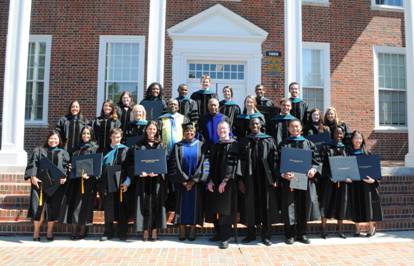Tuesday, October 5, 2010

UMES Awards Doctorates to Largest Physical Therapy Class
Profession recognized during National Physical Therapy Month in October
Heather Bennett saw up close how a physical therapist can make a difference in someone’s life when Bennett’s mother tore one of her anterior cruciate ligaments, also known as an ACL. The therapist worked with her mother to ease her pain and restore mobility after she ruptured the tissue in her knee that connects the thighbone to the shinbone.
“That’s how I found out what I wanted to do with life,” said Bennett, 24, who enrolled in the University of Maryland Eastern Shore’s Doctor of Physical Therapy Program three years ago.
Bennett and 22 other UMES students recently earned their physical therapy degrees during a graduation ceremony held in conjunction with Founders’ Day convocation. The class of 2010 is the university’s largest since the inaugural class of doctoral students graduated in 2005. Newly minted graduates are now eligible to sit for the professional licensure exam to earn the credential that most employers require when hiring physical therapists.
“I’m a little nervous about the test, but I think the program at UMES has definitely prepared me for it,” said Bennett, an Ellicott City resident.
UMES graduates boast a 100-percent passing rate on the National Physical Therapy Exam, according to Dr. Raymond L. Blakely, chairman of the Department of Physical Therapy. He’s confident the class of 2010 can keep that streak alive. Blakely believes his faculty’s “student-centered” approach to teaching is the key to graduates’ success on the test.
“They spend a lot of time working one-on-one with the students,” Blakely said. “We also have a top-notch curriculum.”
UMES’ Doctor of Physical Therapy Program is a three-year course of study that combines clinical and classroom experiences. Classrooms, laboratories and faculty offices are located on campus in Hazel Hall, which features state-of-the art teaching and laboratory equipment.
Graduates are prepared to carry out the responsibilities of health care providers, practicing prevention, examination, and intervention in acute care, outpatient and other rehabilitation settings, Blakely said. The doctoral program also prepares students to contribute to the field of physical therapy through research and other scholarly activities.
Blakely noted that “UMES is one of two Doctor of Physical Therapy programs offered in the state.” The other is the University of Maryland’s downtown Baltimore campus.
Shannon Davis, a Salisbury University graduate, enrolled in UMES’ physical therapy program because of its excellent reputation. The 25-year-old Hagerstown resident had a job lined up before she received her diploma Sept. 13. She accepted a position as a traveling physical therapist.
“I really like working one-on-one with patients and making a difference in their lives,” Davis said.
Fellow graduate Dave Hartwig, 26, said he has already received multiple job offers. He enjoys the fact that he can be “choosy,” especially in a sluggish economy when jobs are difficult to find.
“I had the chance to shadow a physical therapist for a day in high school and I was sold,” said the Baltimore native. “I also saw the potential to make a really good salary.”
Maryland is considered one of the top paying states in this occupation, according to the U.S. Bureau of Labor Statistics. In May 2009, the median annual income of physical therapists was $76,22

